How to Cite | Publication History | PlumX Article Matrix
Kruti Dave* , Parth Darji , Fenie Gandhi, Saumya Singh and Digvijaysinh Jadav
, Parth Darji , Fenie Gandhi, Saumya Singh and Digvijaysinh Jadav
Department of Biotechnology, Mehsana Urban Institute of Sciences, Faculty of Science, Ganpat University, Gujarat, India
Corresponding Author E-mail: davekruti2@gmail.com
DOI : http://dx.doi.org/10.13005/bbra/2903
ABSTRACT:
Owing to the fact of future energy demand, and the clampdown world is facing now, there is a crucial requirement for the sustainable energy sources which are cheap and environmentally friendly.As committed by a green alternative, for future enhancement of the planet, the fossil fuel abandonment is required, and instigation of renewable resources such as Microbial Fuel Cell [MFCs] and Plant Microbial Fuel Cell [PMFCs] should be implemented. MFC is a visionary technique, as it converts wastage into the energy, whereas, PMFC is a new-fangled technique devoid of any climatic conditions and it requires less investment. By scrutinizing this technique, Bacillus megaterium and sewage material are used in MFCs, whereas Azolla and Trigonellafoenumis used in PMFCs, which converts chemical energy into electrical energy with the help of electrons flowing from the anode to cathode via circuit. The individual setup of each MFCs and PMFCs are examined diurnally for voltage and current gain proceeded by connecting both [MFC and PMFC] in series with LED between, thus gaining the luminance in LED.The yield in voltage and current were measured for different fuel cells from Day 1 to Day 12 and Obtained notable difference in both voltage and current. Voltage Difference: MFC;0.041 to 1.733,BMFC;0.271 to 1.885, PMFC(Azolla); 0.00 to 0.35, PMFC(Fenugreek); 0.01 to 0.766 and Current difference: MFC; 0.001-1.133, BMFC; 0.001-1.133, PMFC(Azolla); 0.00 – 0.2, PMFC(Fenugreek); 0.00 – 0.512.The assurance in the aptness of this process, can be evaluated by its exertion in the society. As known its major application is production of electricity from the organic as well as inorganic waste in the environment, and by the plants. Majority of the industries have gone through this manner for the bioenergy and biosensors production and wastewater treatment.
KEYWORDS: Bioelectricity; Electricity; fossil; MFC; PMFC
Download this article as:| Copy the following to cite this article: Dave K, Darji P, Gandhi F, Singh S, Jadav D. Bioelectrochemical System: An Eco-Friendly Approach to Generate Electricity-Utilizing Plants and Microorganisms. Biosci Biotech Res Asia 2021;18(1). |
| Copy the following to cite this URL: Dave K, Darji P, Gandhi F, Singh S, Jadav D. Bioelectrochemical System: An Eco-Friendly Approach to Generate Electricity-Utilizing Plants and Microorganisms. Biosci Biotech Res Asia 2021;18(1). Available from: https://bit.ly/2RwHL9H |
Introduction
With a developing total populace and increasing welfare, energy request overall world is expanding.1 Major of the energy is utilised as electricity and significant commitments in creating electricity originates from the non-sustainable sources of energy for example fossils. As of now used petroleum products are unevenly disseminated over the world, are being drained, and are non-renewable. Excessive utilisation of non-renewable energy sources like fossils presents ecological dangers and has brought about the quest for economical sources of energy.2
Monetary development, computerisation, and modernisation for most part rely upon the security of energy supply. Worldwide energy request is quickly developing, and by, the overall concern is on the best way to fulfil the future energy request. The long-haul prognosis demonstrates that the energy request will quickly increase around the world. Fossil fuels have been employed as imperative energy sources to access the energy demands. The fossil fuels produce ozone–harming substances that profoundly influence nature and the group of people yet to come. The emanations to a great extent rely upon the outflow circumstances of essential power sources (i.e. plant’s insertion fuel). The discharge element among the energy sources, petroleum products (i.e., oil, flammable gas and coal) exceptionally has an emission factor. For energy generation, fossil fuels are chiefly employed as fundamental fuel.(Fig:1)
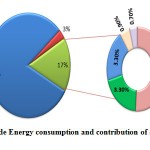 |
Figure 1: Worldwide Energy consumption and contribution of Sustainable energy. |
Given that CO2 is the largest segment of ozone-damaging substances (GHGs), there is a global issue regarding the removal of carbon emissions. In this way, various methods should be used to minimise carbon outflows, such as improvising a balanced system of power supplies and empowering mechanical innovations. In addition, enabling elements, such as feed-in levies, inexhaustible portfolio guidance and tax policies, are committed by the government to improving the production of green energy and, in addition, actively enforcing to conserve energy4.
MFCs or Microbial Fuel Cells have indicated extraordinary guarantee as a unique vitality collecting innovation that can give predictable, support-free force for significant stretches of time. It converts the wastage into the energy with no environmental footprint. An MFC is a type of construction where microbes transform the chemical energy provided by the oxidized forms of natural or inorganic compounds into ATP i.e., energy by repetitive responses into which the electrons are transferred to a final electron acceptor to form an electrical flow. Throughout the time, numerous headway and alterations were done in MFC advances. PMFC was purposed with consolidating a plant at an anode region as the source of substrates for microorganisms.5
A standard MFC comprises two segments an anode and a cathode, which are parted by a proton exchange membrane. Microorganisms dwell in the anodic segment where, they metabolizing organic compounds for example, glucose which goes about as e– benefactor. The process of metabolization of such organic compounds leads to the generation of protons and electrons.6The electrons are then transferred to the surface of anode. From there, the electrons shift to the cathode from the external electrical circuit, whereas the protons relocate with the help of electrolyte and further by the proton exchange layer. By reducing soluble electron acceptors, such as hexacynoferrate or oxygen or acidic permanganate, protons and electrons are used in the cathodic chamber. The electrical power is obtained when a load is placed on the external electrical circuit between two electrode segments.7
It can be divided into two main forms depending on the MFC structure: one is a single chambered MFC, while the other is a dual chambered one. The MFC, which is described in the statement above is containing two separate chambers, one cathodic and one anodic chamber. Thus, it is known as a dual chambered MFC. Although, the construction that contains only a single chamber in which both the cathode and anode are present in solitary is known as single chambered MFC.8
Many assortments of substrates have been utilised in MFC. The substrates do not impact the necessary organisation of the bacterial network in the anode biofilm, yet in addition the MFC execution includes the Columbic productivity and force thickness. During the advancement of this innovation, various substrates having lower molecular weight were utilised as substrates, for example, sugars such as glucose, fructose, sucrose, xylose, maltose and trehalose; organic acids, for example, acetic acid derivation, butyrate, propionate, succinate, malate, lactate, alcohols, for example, methanol and ethanol and inorganic mix, for example, sulfate. Moreover, some complex carbon sources present in wastewaters from various sources were likewise tried for generating bioelectricity.9
So, inside the MFC, microorganisms act like catalysts for breaking down of substrates such as sugar and other substrates that are present in their periphery environment and they release a small amount of energy present within those molecules as electrical energy. The usage of MFC as an elective hotspot for power generation is taken into consideration as a proficient, dependable and perfect procedure that uses inexhaustible techniques and does not create any potentially dangerous side effect. Hence, in recent times, MFCs have proven to be a potential technique for recovery and for the production of electricity from chemical energy.
The Plant-Microbial Fuel Cell (PMFC) is an innovation that can be used in climate free, at wherever on the planet where plants can develop, without rivalry with nourishment or feed creation, and with low investment costs.10
The PMFC yields solar orientated energy to produce electricity by the process of electricity produced by the bacteria via the oxidation of organic compounds which are decomposed by the plants in the rhizosphere. The point of the PMFC is to transfer sun-oriented energy into electrical energy by oxidisation of rhizodeposits done by electrochemically dynamic microorganisms. Simultaneous bio-electricity and biomass creation settle on PMFC an engaging decision for the future environmentally friendly electrical energy.11
Bio systems contain non-living and living segments, interconnected to accomplish a bound together reason concerning food production, natural conservation, monetary improvement, and innovative headway. The process of photosynthesis, which converts solar radiation into carbohydrates and further reactions converting carbohydrates finally into biomass is a series of interconnected transformations and a classic example of a biosystem. In comparable design, a PMFC captures the root exudates from photosynthesis and convert it to bioelectricity with a guide of microbial metabolism.
Nonetheless, trees, escorted by the exudation of staying half to the rhizosphere, devorate 40 percent of their vitality by themselves. Microorganisms populated in the soil-encircling rhizosphere are materialised by the disintegration of organics to fetch electrons. This wonder is caught by more PMFC, and the anode locale confines electrons discharged by organisms. Control is provided at the stage where the electrons go into the heap and live at the end of the circuit at the cathode, expected to be “bio-electricity.” Consequently, electricity is generated by the redox gradient between two electrodes.11
A PMFC can be used as an expanded range of feasibly organised bio structures. To attain voltage, the bio control complex (plant) gets the outer data signal (daylight). The complex of the bio process (microbial population) lays hold of material assets (root exudates) and tracks them to generate yields (voltage). (Fig: 2) Based on unsettling factors, this arrangement induces varieties in the yield and itself all the while. The active signal (sunlight) can be reshaped in the case of an open-loop bio device, thereby influencing the outputs.12
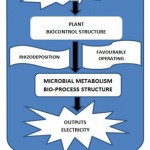 |
Figure 2: Bio process complex. |
This innovation involves multidisciplinary regions running from the investigation of microorganisms, plants, electrochemistry and different engineering fields. (fig:3)
In this study, we examine MFC by using Bacillus megaterium and sewage material and PMFC by using Azollaand Trigonella foenum. The fundamental targets is the creation of bio-electricity that implies less malicious to the earth. Sewage, for example, benthic is blends of natural and inorganic parts. It furnishes with an unconventional type of energy. Benthic soil contains network of organisms electrogenic and helpful in MFC activities.12 Microbes produce bioelectricity from their natural metabolism by using the nutrient present in their environment. It guarantees ceaseless energy, long span support-free bio-electricity. Sewage the untreated waste, that messes sanitation up is being dealt with MFC innovation.
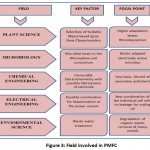 |
Figure 3: Field involved in PMFC mechanism.
Click here to view figure |
Along this agenda, bestow of waste occur and best conception as bio electricity is brought up. Contrary, Bacillus megaterium is omnipresent in soil. Electrochemically active redox enzymes are present in bacteria as mediator less MFCs, at their outer membrane that transmits electrons to external materials, as a consequence, needless of exogenous chemicals to accomplish electron transfer to electrode.13
The strain of megaterium is easy to cultivate and is a source of bioremediation. It requires less maintenance and is easy to handle. It is very efficient and generates bio-electricity for a longer time.14 (FG) is a plant seeds turned out to be verifiably utilised in cooking, herbal remedy, anti-microbial, anti-inflammatory, anti-oxidative, anti-cancer, anti-diabetic effects. Germination of Fenugreek vitals 5–10 days, while primary trifoliate leaf seems 5–10 days after germination. It is a quickly flourishing plant that may grow especially on dry meadows, built or arid terrains, hills, planes as well as field edges, but its vitality is a lot of sunshine. India is a significant maker, with fenugreek creation in India got from various states. Rajasthan represents more than 80% of India’s yield. Azolla, a free-gliding water plant is another quickly developing plant, which can develop without nitrogen (N) in water in view if a cooperative relationship with the nitrogen fixing endophytic blue-green cyanobacteria, Anabenaazollae.Azolla species have been seriously concentrated because of their high development rates joined with high bioremediation productivity. Along these lines, the azolla and fenugreek species are selected for the forthright audit in any case, any earthbound and amphibian plant can be utilised to create bio-electricity.
In developing nations, towns and homesteads could become autonomous by using this adaptable innovation, while developed countries could minimise their nursery experiences by drawing support from wetlands, nurseries or bio-processing plants. This study uncovers the numerous developments and implementations of MFCs and PMFCs.
Method and Construction
MFC of Microorganism
Many designs are feasible for MFCs. Normallyused and reasonable structure is a two – chamber MFC work in a conventional “H” shape, which contains two chambers, an anode and cathode.15
Bacillus megaterium acts as a biocatalyst present in the anaerobic anodic chamber while cathodic chamber contains NaCl solution for the production of bio-electricity.16
The salt bridge, which includes agar-agar and 0.1 M NaCl solution, divides the two chambers.
The modulation of this structure is to pick a film that permits protons allying the chambers to forestall particle saturation.
The most habitually utilised terminal in anode and cathode are composed of carbon materials containing graphite pole are used for steadiness in microbial societies, high electric conductivity and tremendous surface area.
On applying a resistor over the outside circuit, the voltage drop over the resistor and current moving through the resistor is estimated with the assistance of a multimeter. (Fig:4)
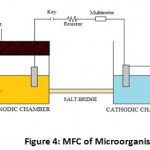 |
Figure 4: MFC of Microorganism. |
MFC of Benthic soil
The Benthic soil – MFC sticks to a similar fundamental standard of MFC.
A single – chambered MFC was utilised with benthic soil.(Fig:5)
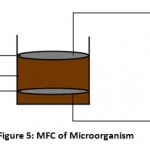 |
Figure 5: MFC of Microorganism. |
Benthic soil was obtained from cesspits, and has numerous microorganism present in it.17
The bioelectrogenic cells arrangement, which are comprised by plastic with the accompanying measurements: 10 x 8 x 10 cm, and inside an aggregate of 250 gm of Benthic soil was housed.18
The materials used for both electrodes creation is graphite rod.(6.0 x 0.5 cm) Anode placed at base and cathode placed at the uppermost section, both electrodes are attached with copper wire and the copper wires are connected to a variable resistor and controlled by a wireless multimeter, finally complete a circuit.19
Terrestrial PMFC
This construction of PMFC is done using terrestrial plant in a pot having tainted soil. The plant Trigonella foenum-graecum regularly known as Fenugreek is utilised in the accompanying development.
A graphite sheet electrode of size 6 cm x 6 cm is used as the anode and cathode. The anode is arrangement beneath the plant roots while the cathode is placed on the soil surface around the emerging shoot.
A copper wire is drawn from both the anode and cathode, which is used to setup an external circuit. The anode transfers these electrons cathode which is in direct contact with air.
As electrons move to the cathode by using copper wires utilising outer circuit and the protons move towards the cathode from the soil.11
On applying a resistor over the outside circuit, the voltage drop over the resistor and current moving through the resistor is estimated with the assistance of a multimeter.(Fig:6)
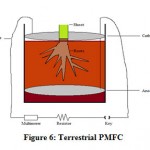 |
Figure 6: Terrestrial PMFC. |
Aquatic PMFC
This construction of PMFC is done using aquatic plant Azolla. Lam. commonly known as mosquito fern.
This construction requires 2 chambers, one chamber in which the Azolla is grown, which is also known as the Anode of the cell and another chamber that consists of salt water which is also known as the cathode of the cell.
An oxygen pump is kept in the cathodic chamber to keep it constant oxygen rich.
The two chambers are connected internally by a salt bridge that uses 2% Agar-Agar solution + 0.1 M NaCl solution to avoid ion saturation and is connected externally by copper wires threaded into the graphite electrodes of each chamber.11
As electrons move to the cathode through copper wires utilising outside circuit, the protons move towards the cathode from the salt bridge. On applying a resistor over the outside circuit, the voltage drop over the resistor and current moving through the resistor is estimated with the assistance of a multimeter.(Fig:7)
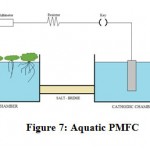 |
Figure 7: Aquatic PMFC. |
Result and Mechanism
MFC and BMFC
The dialogue from methodology, explains that the three systems each BMFC and MFC of microorganisms are connected in series. The BMFC is single chambered while MFC of microorganisms is dual chambered. To escalate the voltage output the systems are connected in series. (Fig:8) Both systems were perceived synchronically. By this exposition, we observed stately result.(Table:1)
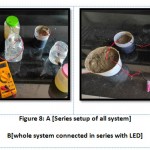 |
Figure 8: (A )Series setup of all system. (B) whole system connected in series with LED. |
Table: 1 Electricity Generation diurnally.
| TIME | BMFC | MFC | ||
| Day | Volts | mA | Volts | mA |
| Day1 | 0.271 | 0.001 | 0.041 | 0.000 |
| Day2 | 0.324 | 0.039 | 0.480 | 0.001 |
| Day3 | 0.480 | 0.079 | 0.498 | 0.010 |
| Day4 | 0.498 | 0.324 | 0.499 | 0.032 |
| Day5 | 0.499 | 0.324 | 0.631 | 0.113 |
| Day6 | 0.542 | 0.524 | 0.639 | 0.271 |
| Day7 | 1.009 | 0.618 | 1.009 | 0.324 |
| Day8 | 1.148 | 0.698 | 1.393 | 0.388 |
| Day9 | 1.424 | 0.883 | 1.458 | 0.410 |
| Day10 | 1.733 | 0.906 | 1.508 | 0.618 |
| Day11 | 1.883 | 1.126 | 1.645 | 1.126 |
| Day12 | 1.885 | 1.133 | 1.733 | 1.133 |
In the ambition of obtaining constitutive results, the setup was connected in series for a couple of days. After 12th day, when gained potential voltage 1.5Volts another cell of 1.5Volts was connected with whole series. In the extension, An LED was affixed with whole system and a switch was joined. From the above cessation, we can say that by connecting the system in series we got tremendous results.
During the whole process, BOD and COD were measured of benthic soil. A single-chamber MFC was used with domestic sewage wastewater had BOD=110mg/L, COD=250mg/L, TOC=80mg/L. BOD( Biological Oxygen Demand) and COD (Chemical Oxygen Demand) are both measuresof the amount oxygen needed to oxidise the Organic material available in a given sewage sample. The difference between them is BOD being a test of the level of organic material that can be biologically oxidized while COD determines the amount of organic matter chemically. BOD and COD help to facilitate the electron transfer from microbial cells to electrode. BOD can be used as sensors which help to directly measure the potential voltage. The efficiency of the MFC can be very closely checked by the BOD test and the function of the MFC can be enhanced.
Mechanism
Benthic soil is composed of organic and inorganic matter that comprises innumerable diverse system of microorganisms that flourish on distinct different electron donors and acceptors. Anode is positioned below in the benthic soil under anaerobic conditions and above it cathode is located under aerobic conditions connected by an external circuit.
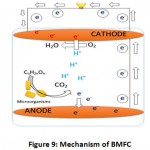 |
Figure 9: Mechanism of BMFC. |
The microbes will form a biofilm on the surface of the anode, oxidise the organic and inorganic matter generating highly reduced biomolecules like NADH. These electrons produced through them are then transferred to the anode. Further the electron moves to the aerobic area i.e. cathode. Then, oxygen is reduced when accepts electrons and reacts with protons to form water molecules. In consequence, bio-electricity is generated. The difference in potential generated between oxidation and reduction reaction allows this process to be used as electric current. (Fig:9)20
In case of MFC, it contains cathode and anode separated by a proton exchange membrane connected by an external circuit. On this planet, there is a manifold of microorganisms with their distinct metabolic pathways that sanction them to reduce oxidised metal such as iron oxide that carry respiration. Electrogenic microbes, which canbreathe metal compounds homogenous to other organisms. Microorganisms present in the anodic chamber, metabolise the given organic substance and generate biomolecules such as NADH and generate electrons (e-) and protons (H+). On the outer membrane of bacteria, they have active redox enzymes through which electrons are transferred and through exogenous chemical they attain the electron moved to the electrode. By means of electron mediators or shuttles, electrons are transported to the anode by direct membrane-associated electron transfer by so-called nanowires formed by bacteria. A terminal electron accepter (usually oxygen) in the cathode chamber is where protons and electrons form water molecules. An external circuit conducts the electrons on the cathode and protons pass across the salt bridge. This whole process, thus, gives rise to bio-electricity. (Fig: 10)
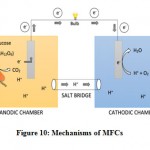 |
Figure 10: Mechanisms of MFCs. |
PMFC
The three setups each of fenugreek and azolla were connected in series individually (Fig:11) and the results were noted. (Table 2)
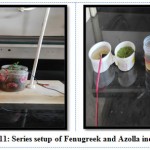 |
Figure 11: Series setup of Fenugreek and Azolla individually. |
Table 2: Electricity Generation diurnally
| DAY | Fenugreek PMFC | Azolla PMFC | ||
| Potential difference | mA | Potential difference | mA | |
| DAY 1 | 0.010 | 0.000 | 0.000 | 0.000 |
| DAY 2 | 0.040 | 0.000 | 0.000 | 0.000 |
| DAY 3 | 0.120 | 0.003 | 0.018 | 0.002 |
| DAY 4 | 0.202 | 0.011 | 0.022 | 0.005 |
| DAY 5 | 0.298 | 0.075 | 0.044 | 0.020 |
| DAY 6 | 0.334 | 0.086 | 0.098 | 0.062 |
| DAY 7 | 0.356 | 0.121 | 0.145 | 0.102 |
| DAY 8 | 0.404 | 0.208 | 0.220 | 0.111 |
| DAY 9 | 0.523 | 0.456 | 0.296 | 0.201 |
| DAY 10 | 0.766 | 0.512 | 0.350 | 0.200 |
According to the previous words in methodology, both the system are assembled in opposition to each other i.e. the terrestrial is put on using a single chamber while the aquatic is using dual chamber to compensate for feasibility in work. The improvement is finally indicated in the account of this on the diurnal rhythm.In expectation of the fruitful result, the unabridged set of PMFC is bound together in series and is secured for a couple of days for the static result. After gaining the potential difference by 1.50 V a cell of potential difference 1.5 V is connected with the continuation with L.E.D. and a switch at one culmination point. (Fig:12)
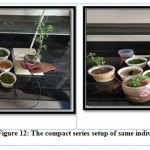 |
Figure 12: The compact series setup of same individual |
As per the conclusion, we can say that the series connection leads to superior generation of electricity, which gratifies our saying of green electricity and can conserve much of the world’s energy.
Mechanism
As per the photosynthesis, plant utilises photons as the light energy to form glucose as the vital component.
Organic matter is derived from renewable sources, such as sunlight and CO2, by the photosynthesis process in plants. Approximately 70% of this organic matter leads to the Dead matter found in soil, such as root material, mucilage, lysates and exudates. Bacteria, which live on and around roots oxidize organic matter that releases CO2, protons, and electrons. The reactions occur as below:
According to the previous paragraph, by way of the external circuit, the anode is bound to the cathode and the anode side, which releases protons, is transited by a membrane or spacer to the cathode. The electron flow is guided by an external circuit, i.e. from anode to cathode, where the reduction of oxygen along with electrons and protons produces water. (Fig:13)
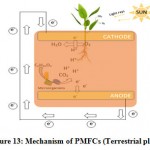 |
Figure 13: Mechanism of PMFCs (Terrestrial plant). |
When PMFC, the bio- system is built, the condition of plant influences the enclosed soil and thus engendered output power changes subsequently. Nutrition fulfillment of bacteria by the photosynthesis process is the fundamental duty of plant. Due to that, an unsound plant will lower the performance of PMFC, that would dry up the nutrients. In this wise, estimation the growing flora in the similar environment can also be accomplished by keeping a track of output power. (Fig:14)
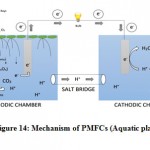 |
Figure 14: Mechanism of PMFCs (Aquatic plant). |
Discussion
The amenities that use renewable sources to produce electricity have been adapted by most nations. The exorbitant use of non-sustainable energy sources is close to the substantial use of elective energy sources, contributing to improvements in the environment. The creation of renewable energy source advances is motivated by three basic inspirations: energy securities, economic impacts and decrease in CO2 emanation. Microbial Fuel cell (MFC) and Plant Microbial Fuel Cell (PMFC) positively assure igneous energy scavenging, which contributes perpetual, and concurrently maintainable energy granting lengthy duration.
The conventional PMFC setup as displayed by Sudirjoet al can only be applicable to plant species like Oryzasatvia. With our exclusive design we can incorporate the same mechanism into Trigonellafoenum-graecummaking it one of its first kind to display a completely terrestrial PMFC20. At the other end of spectrum, using Azollaas a pure aquatic plant also marks an achievement for the multipurpose use of Azolla. The plant excels in vitamin contains like Vitamin B12 and Vitamin A along with fibres. It also houses a formidable nutritional capacity with 20-30% of nutrition being pure protein. Its major use is being used as a fodder for cattle which also increases its lactation capacity by 8-15%. By implementing PMFC in the Azolla, a power plant in the future can be obtained.
As of the late attention has been on sustainable power sources. Strategy producers should advance inexhaustible assets (sun powered, wind, hydropower, biomass, and geothermal) for maintainable and neutral-carbon energy. The twentieth century energy framework can be mutated with brilliant framework as new dependable, astute, flexile, mutual web, and stabilised which empowers financial empowerment, collapse of environment, functionally adept power safety, also expanded user authority. While considering clean advances, two essential ideas for power innovation: power–funding technologies, that allude towards elective wellsprings concerning sustainable power sources (for example: air, sun-based force), also power proficiency advances, either such advances that are especially recruited for improving power usage effectiveness, (for example: cogeneration power plant, virtual power plant [VPP], smart meters). Necessary to notice, by changing the power segment, also by supplanting regular power along a sustainable power source, which relates transformative to change in technologies, and farming business.
In the case of MFC and BMFC systems, its application in toxicated land reduces the concentration of pollutants in soil by demeaning them and increases the efficiency of bioelectricity generation. While BMFC requires the soil for operation, the MFC is functioned in complete absence of soil and reacts in bacterial culture21.
Mfc and Pmfc Affected by the Factors Are
Microbial fuel cell (MFC) is an advanced innovation, which will be utilised for power generation during the oxidation of natural substances introduced in the substrate. Few factors are significant because of their metabolism and the mediators which are used by them for transferring electrons to the anode. There are various substrates that can be used in the MFC and oxidised by microorganisms as the wellspring of electron contributors.Working conditions, such as temperature, ionic pressure, pH of the medium, cathode structure and content, anode and membrane, could have a major effect on power production. Figure 15 summarises these factors.
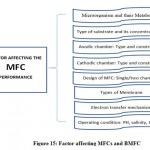 |
Figure 15: Factor affecting MFCs and BMFC. |
Designing the electrode is the greatest challenge in making MFC a scalable and cost effective technology. Recently, interest in the configuration of electrode material has steadily increased in studies for MFC. Over the past decade, a large number of electrodes have been explored extensively for MFC. It is important to recognise and consider these essential factors to have a highly efficient MFC.22
This investigation represents a PMFC as an engaging wellspring of supportable and sustainable energy source. Factors influencing the activity of PMFC have been exhibited as far as the impact of plants, impact of organisms, and arrangement structure. (Fig:16) Research on PMFCs involves the performance of C4 pathway plants is better in PMFCs, anyway the framework execution is subject to different elements such as anode materials and working parameters. Plant and soil types are important factors for forming microbial networks that can at last modify the force yield. The voltage generation trend is affected by the principle of exudation used by organisms. The morphology of roots and biomass, anode construction, and setup plan influence the bio energy collect from PMFCs.23
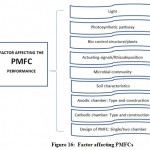 |
Figure 16: Factor affecting PMFCs. |
Commercialization of MFC and PMFC
Commercialisation of every affluence infrastructure is becoming dependant, as sold and utilised for significant quantities. For this, we must rely on any parameter like technology, government sources, available sources, cost prices, school, instruments and facilities etc. the connexion between these parameters is seen in fig:17.
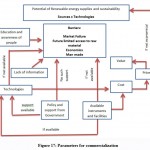 |
Figure 17: Parameters for commercialization. |
Major Pit Holes of the Technology and Solution
Highly assured technology for power generation by engaging in waste material i.e., MFC and PMFC, abidesby many challenges, which obstruct its commercialisation. Some major pit holes are as follows.24(Fig:18)
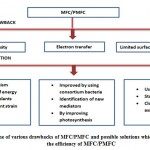 |
Figure 18: Outline of various drawbacks of MFC/PMFC and possible solutions which can help to enhance the efficiency of MFC/PMFC. |
Xenobiotic and waste provide power density to MFC is comparatively less than pure carbon sources such as glucose. Thus, this implies the major hindrance in management of waste and electricity generation for day to day.
Wastes are cheap comparatively to the cost of pure for carbon sources so they cannot be engaged customarily for electricity generation.
A good understanding of plant-microbe relationship is the key to high quality performance of PMFC. Each plant cannot produce electricity, so selection of plants should be proper.
During the mounting of MFC and PMFC, the element usage for cathode/anode along with membrane is expensive that hampers commercial marketing.
Conclusion
The PMFC and MFC are new and inventive innovation that has tremendous ambit for advancement and practical appropriateness in the advent future. With depth research, plants and microorganisms as a wellspring of power can be novel innovation for development of green rooftops or bio panels in urban zones. Fruitful plan and improvement of PMFCs can be manageable wellsprings of bio–electricity of rural regions. Hence, PMFCs has the extension to be actualized in different government and non–government workplaces, singular families, networks and instructive foundations for advancing a green and solid atmosphere, with the additional prefered position of renewable and sustainable bioelectricty. Likewise, electricity production from the metabolism of microorganisms is an artistic technology in MFC. Applying the MFC mechanism with appropriate modifications, wastewater plants can also generate bioelectricity. Along these lines, to make a genuine application conceivable, pervasive technology is highly imperative to make it cost effective with ease of maintenance, so that easily acceptable for most people in eventual years. Therefore, in the future, PMFC and MFC proved competitive technology, it could be agreed that during the coming decade it would increase an economy of scale profit.
Acknowledgement
This work would have not been possible without the support of Ganpat University. I am grateful to all of those with whom I have had the pleasure to work during this review.
Conflict of interest
The authors declare that they have no conflict of interest.
References
- E.Sudirjo and C J N Buisman and D P B T B Strik, Electricity generation from wetlands with activated carbon bioanode,(2018) Conference Series: Earth and Environmental Science,vol-131,doi:10.1088/1755-1315/131/1/012046
CrossRef - E.Sudirjo and C J N Buisman and D P B T B Strik, Electricity generation from wetlands with activated carbon bioanode,(2018) Conference Series: Earth and Environmental Science,vol-131,doi:10.1088/1755-1315/131/1/012046
CrossRef - Shana M. McDermott, Richard B. Howarth, David A. Lutz,(2015) Biomass Energy and Climate Neutrality: The Case of the Northern Forest,Land Economics vol. 91 no. 2 197-210,doi: 10.3368/le.91.2.197
CrossRef - Chrips, Nesayyan R.,Razafindrabe, Bam H.N.,Williams, Ben C.,Vinod, Raghavakurup T.(2019)A GIS-based study on the estimation of fixed atmospheric CO2 in tropical tree biomass from Neyyar Wildlife Sanctuary, South India ,doi:10.1080/19475683.2019.1664632
CrossRef - I Daniel Posen,PaulinaJaramillo,Amy E Landis,W Michael Griffin,(2017) Greenhouse gas mitigation for U.S. plastics production: energy first, feedstocks later, Environmental Research Letters,vol-12(3)doi = 10.1088/1748-9326/aa60a7
CrossRef - Bombelli P, Dennis RJ, Felder F, et al. (2016) Electrical output of bryophyte microbial fuel cell systems is sufficient to power a radio or an environmental sensor. R Soc Open Sci.3(10):160249.doi: 10.1098/rsos.160249.
CrossRef - Maxvell Gustavo JIMÉNEZ-ESCAMILLA, Claudio GARIBAY-ORIJEL, Manuel Antonio BORJA-SALIN(2018) MODELO BIOQUÍMICAMENTE ESTRUCTURADO PARA LA ESTIMACIÓN DE LA EFICIENCIA DE UNA CELDA DE COMBUSTIBLE MICROBIANA ,Unidad Profesional Interdisciplinaria de Biotecnología (UPIBI) 34 (2) 331-345, 2018 DOI: 10.20937/RICA.2018.34.02.13
CrossRef - DuttaSinha S, Chatterjee S, Maiti PK, Tarafdar S, Moulik SP. Evaluation of the role of substrate and albumin on Pseudomonas aeruginosa biofilm morphology through FESEM and FTIR studies on polymeric biomaterials. ProgBiomater. 2017 May;6(1-2) 27-38. doi:10.1007/s40204-017-0061-2. PMID: 28155216; PMCID: PMC5433955.
CrossRef - R Lalitha Priya and T Ramachandran and P V Suneesh(2016), Fabrication and characterization of high power dual chamber E. coli microbial fuel cell, Conference Series: Materials Science and Engineering, vol-149,doi :10.1088/1757-899x/149/1/012215
CrossRef - Goto Yuko, Yoshida Naoko, UmeyamaYuto, Yamada Takeshi, TeroRyugo, Hiraishi Akira,(2015) Enhancement of Electricity Production by Graphene Oxide in Soil Microbial Fuel Cells and Plant Microbial Fuel Cells,Frontiers in Bioengineering and Biotechnology, DOI=10.3389/fbioe.2015.00042,ISSN-2296-4185
CrossRef - SoumyaPandit, DebabrataDas(2015), Role of Microalgae in Microbial Fuel Cell, Algal Biorefinery: An Integrated Approach, ISBN : 978-3-319-22812-9
- Reimers Clare E.,GirguisPeter,et al.(2016)Independent Benthic Microbial Fuel Cells Powering Sensors and Acoustic Communications with the MARS Underwater Observatory,Journal of Atmospheric and Oceanic Technology,American Meteorological Society,DOI:10.1175/JTECH-D-15-0102.1
CrossRef - MostafaRahimnejad, ArashAdhami, SoheilDarvari, AlirezaZirepour, Sang-Eun Oh,(2015), Microbial fuel cell as new technology for bioelectricity generation: A review, Alexandria Engineering Journal, Volume 54, Pages 745-756, ISSN 1110-0168, https://doi.org/10.1016/j.aej.2015.03.031
CrossRef - NitisoravutRachnarin&RegmiRoshan (2017) Plant microbial fuel cells: A promising biosystems engineering. Renewable and Sustainable Energy Reviews, Elsevier 76(C):81-89.
CrossRef - Extracellular electron transfer mechanisms between microorganisms and minerals. Nat Rev Microbiol. 2016 Oct;14(10):651-62. doi: 10.1038/nrmicro.2016.93.
CrossRef - Sivasankar V., Mylsamy P., Omine K. Microbial Fuel Cell Technology for Bioelectricity.(2018) Springer, Cham. https://doi.org/10.1007/978-3-319-92904-0_2
CrossRef - Lee YS, An J, Kim B, Park H, Kim J, Chang IS (2015) Increased Power in Sediment Microbial Fuel Cell: Facilitated Mass Transfer via a Water-Layer Anode Embedded in Sediment. PLoS One 10(12):e0145430. doi:10.1371/journal.pone.0145430.
CrossRef - Parkash, Anand& Aziz, Shaheen&Unar, Imran &Soomro, Suhail. (2015). UTILIZATION OF SEWAGE FOR VOLTAGE GENERATION IN DUAL CHAMBER MICROBIAL FUEL CELL. Science International Lahore. 27. 5065-5068.
- Fernández F.J., Lobato J., Villaseñor J., Rodrigo M.A., Cañizares P. (2014) Microbial Fuel Cell: The Definitive Technological Approach for Valorizing Organic Wastes. In: Jiménez E., Cabañas B., Lefebvre G. (eds) Environment, Energy and Climate Change I. The Handbook of Environmental Chemistry, vol 32. Springer, Cham. https://doi.org/10.1007/698_2014_273.
CrossRef - Rushika Patel, PurviZaveri&Nasreen S. Munshi (2017): Microbial fuel cell, the Indian scenario: developments and scopes, Biofuels, 10:1,101-108,DOI: 10.1080/17597269.2017.1398953
CrossRef - Sudirjo,Emilius,deJager,Pim,Buisman,Cees J.N. Strik, David P.B.T.B.,(2019),Performance and Long Distance Data Acquisition via LoRa Technology of a Tubular Plant Microbial Fuel Cell Located in a Paddy Field in West Kalimantan, Indonesia,Sensors,VOl:19ISSN:1424-8220 DOI:10.3390/s19214647
CrossRef - Nasirahmadi, S., Akbari-adergani, B.(2018) Microbial fuel cell with a nano-membrane and two expired medicinal drug-feeding cathode: a novel strategy. Int J Energy Environ Eng 9, 249–256. DOI:10.1007/s40095-018-0262-z
CrossRef - Shanmuganathan. P and Rajasulochana. P (2018) FACTORS AFFECTING THE PERFORMANCE OF MICROBIAL FUEL CELLS. International Journal of Mechanical Engineering and Technology 9(9):137-148.
- Chaturvedi V. & Verma P. (2016) Microbial fuel cell: a green approach for the utilization of waste for the generation of bioelectricity. Bioresour Bioprocess 3:38. doi:10.1186/s40643-016-0116-6.
CrossRef

This work is licensed under a Creative Commons Attribution 4.0 International License.








